
The Chaco War was fought from 1932 to 1935 between Bolivia and Paraguay, over the control of the northern part of the Gran Chaco region of South America, which was thought to be rich in oil. The war is also referred to as La Guerra de la Sed in literary circles since it was fought in the semi-arid Chaco. The bloodiest interstate military conflict fought in South America in the 20th century, it was fought between two of its poorest countries, both of which had lost territory to neighbours in 19th-century wars.
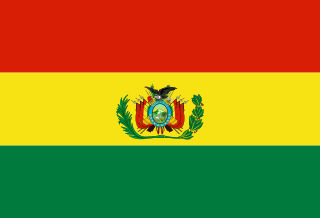
The Bolivian Armed Forces are the military of Bolivia. The Armed Forces of Bolivia are responsible for the defence, both of external and internal, of Bolivia and they are constituted by Bolivian Army, the Bolivian Air Force and the Bolivian Navy. All these institutions depend on the Ministry of Defence of this country.

José Luis Tejada Sorzano was a Bolivian lawyer, economist, and politician who served as the 34th president of Bolivia from 1934 to 1936. The last president to be a member of the Liberal Party, Tejada Sorzano previously served as the 23rd vice president of Bolivia from 1931 to 1934.

Gualberto Villarroel López was a Bolivian military officer who served as the 39th president of Bolivia from 1943 to 1946. A reformist, sometimes compared with Argentina's Juan Perón, he is nonetheless remembered for his alleged fascist sympathies and his violent demise on 21 July 1946.
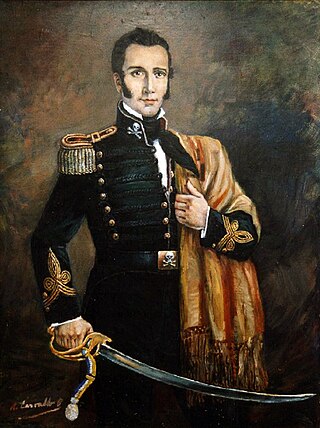
Manuel Xavier Rodríguez Erdoíza was a Chilean lawyer and guerrilla leader, considered one of the founders of independent Chile. Rodríguez was of Basque descent.

The Paraguayan Army is the ground force branch of the Armed Forces of Paraguay. It is organized into three corps and nine divisions, and several commands and direction. It has gone to war on many occasions, notably in the War of the Triple Alliance (1864–1870) against Brazil, Argentina and Uruguay; the Chaco War against Bolivia; and the ongoing Paraguayan People's Army insurgency.
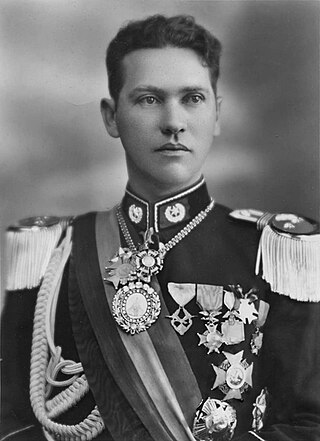
Víctor Germán Busch Becerra was a Bolivian military officer and statesman who served as the 36th president of Bolivia from 1937 to 1939. Prior to his presidency, he served as the Chief of the General Staff and was the Supreme Leader of the Legion of Veterans, a veterans' organization founded by him after his service in the Chaco War.

The Bolivian Army is the land force branch of the Armed Forces of Bolivia. Figures on the size and composition of the Bolivian army vary considerably, with little official data available. It is estimated that the army has between 26,000 to 60,000 men.
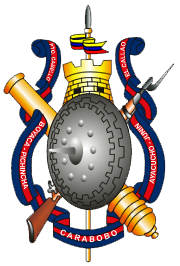
The Venezuelan Army, officially the National Army of the Bolivarian Republic of Venezuela, is one of the six professional branches of the Armed Forces of Venezuela. Also known as Bolivarian Army, its role is to be responsible for land-based operations against external or internal threats that may put the sovereignty of the nation at risk. The army is the second largest military branch of Venezuela after the Bolivarian Militia.

Carlos Quintanilla Quiroga was a Bolivian general who served as the 37th president of Bolivia on a provisional basis from 1939 to 1940. Quintanilla saw action in the initial stages of the Chaco War (1932–1935) and managed to ascend the echelon of the Bolivian armed forces until he became commander of the army during the administration of Germán Busch. When President Busch committed suicide on 23 August 1939, Quintanilla declared himself Provisional President of the Republic.

The Battle of Estero Bellaco was one of the bloodiest battles of the Paraguayan War. The battle was fought on 2 May 1866 with the Paraguayan Army suffering 2,000 casualties among the dead and wounded. Likewise, 300 of their men were taken prisoner by the troops belonging to the Triple Alliance: Argentina, Brazil and Uruguay. The allies lost nearly 2,000 men, mostly wounded, and the Uruguayan troops of General Venancio Flores - commanded by León de Palleja - were severely decimated, accounting for the vast majority of allied deaths.

The 1st Infantry Regiment "Los Patricios" is the oldest and one of the most prestigious regiments of the Argentine Army. The title is often shortened to the Patricians' Regiment. Since the 1990s the regiment has been designated as air assault infantry. It is also the custodian of the Buenos Aires Cabildo, the welcoming party for visiting foreign dignitaries to Argentina and the escort, and honor guard battalion for the City Government of Buenos Aires. Since 22 September 2010, the Regiment's headquarters building has been a National Historical Monument following a declaration by the Argentine government on the occasion of the country's bicentennial year.

The Army of the North, contemporaneously called Army of Peru, was one of the armies deployed by the United Provinces of the Río de la Plata in the Spanish American wars of independence. Its objective was freeing the Argentine Northwest and the Upper Peru from the royalist troops of the Spanish Empire. It was headed by Hipólito Vieytes (1810), Juan José Castelli (1810–1811), Juan Martín de Pueyrredón (1811–1812), Manuel Belgrano (1812–1814), José de San Martín (1814), José Rondeau (1814–1816), Manuel Belgrano (1816–1819) and Francisco Fernández de la Cruz (1819–1820).
The Battle of Pequereque was a clash which took place on 19 June 1813, during the second Upper Peru campaign of the Argentine War of Independence, between scouting forces of the United Provinces Army of the North and the royalist Army of Peru. The republican cavalry of the Army of the North, led by Colonel Cornelio Zelaya, prevailed over the royalists, under the command of Colonel Pedro Olañeta.

The Battle of Campo Grande was a major engagement which took place during the Chaco War, in the southern region of the Chaco Boreal. During this battle, the Paraguayan Army successfully encircled two Bolivian regiments defending two of the three flanks of Fort Alihuatá, forcing them to surrender.
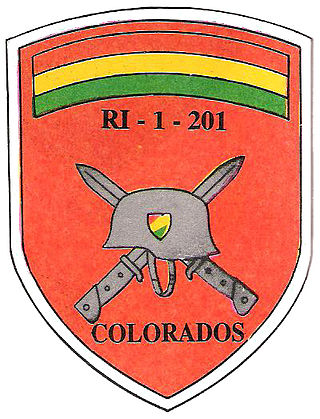
The 1st Regiment of Foot Infantry "Bolivian Colorados" National Presidential Escort Regiment of the Bolivian Army, formerly the 39th Line Infantry Battalion "Colorados" is one of the Army's oldest and most prestigious infantry regiments. It is headquartered in La Paz's Miraflores District, and is under the direct supervision of Bolivian Army headquarters.
Penal military units, including penal battalions, penal companies, etc., are military formations consisting of convicts mobilized for military service. Such formations may contain soldiers convicted of offenses under military law, persons enrolled in the unit after being convicted in civilian courts, or some combination of the two. Service in such units is typically considered a form of punishment or discipline in lieu of imprisonment or capital punishment.

The insurgency in Paraguay, also known as the Paraguayan People's Army insurgency and the EPP rebellion, is an ongoing low-level armed conflict in northeastern Paraguay. Between 2005 and the summer of 2014, the ongoing EPP campaign has resulted in at least 50 deaths in total, the majority of them being local ranchers, private security guards and police officers, along with several insurgents. During that same period the group perpetrated 28 kidnappings for ransom and a total of 85 "violent acts".

Adrián Patiño Carpio was a prominent Bolivian military musician, band director, and music composer. Patiño was responsible for incorporate Bolivian popular folk tradition in the Bolivian Army.
The Macheteros de Jara was an auxiliary cavalry regiment that was organized since August 15, 1932, before the Battle of Boquerón began. The regiment was recruited from former outlaws from Paraguay who fought against Bolivian officers and soldiers.
















